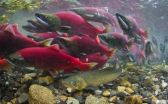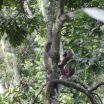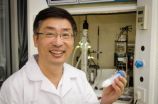(Press-News.org) Imagine having a daylong Thanksgiving feast every day for a month, then, only pauper's rations the rest of the year.
University of Washington researchers have discovered Dolly Varden, a kind of trout, eating just that way in Alaska's Chignik Lake watershed.
Organs such as the stomach and intestines in the Dolly Varden doubled to quadrupled in size when eggs from spawning sockeye salmon became available each August, the researchers found. They were like vacuums sucking up the eggs and nipping at the flesh of spawned-out salmon carcasses.
Then, once the pulse of eggs and spawning salmon ceased, the guts shrank and the fish lived for nearly a year off the reserves they'd built up because there is little else to eat.
Certain snakes, birds about to migrate and Atlantic cod in the laboratory are known to grow and shrink their digestive track in response to gorging, but this is the first time researchers have documented wild fish doing so, according to Jonathan Armstrong and Morgan Bond, UW doctoral students in aquatic and fishery sciences when the work was conducted. They are the authors of a paper in the Journal of Animal Ecology published online March 20.
Dolly Varden, bull trout and brook trout are among the North American members of the char family, part of the larger trout and salmon lineage. These particular Dolly Varden live where insects and other prey are scarce because of the long, cold winters. The fish can't do without the yearly egg "subsidy." Survival depends on there being lots of returning salmon, spawning naturally.
Depleted runs or rivers full of salmon returning to hatcheries just won't do it, a factor for managers to consider if it turns out other fish have evolved the ability to grow and shrink their guts to take advantage of food pulses.
"Wild salmon runs have been dramatically reduced across much of the lower 48 states and often are replaced with hatchery fish," Armstrong said. "When salmon are spawned in hatcheries, bull trout – which are threatened in the Pacific Northwest – as well as juvenile coho salmon and other species of concern to conservationists no longer have the opportunity to feed on salmon eggs, which are an incredible food source.
"Our society invests heavily in restoring stream ecosystems. Our study emphasizes the importance of conserving food webs. You can pay millions of dollars to add wood to a stream and take other steps to restore habitat but if there's nothing for fish to eat, you might not see positive results," Armstrong said.
It appears that Alaska is protecting coastal watersheds and conserving the inherent productivity of salmon runs, the authors said, and there are enough salmon to support commercial fisheries that harvest half, or more, of the returning fish as well as upstream consumers like Dolly Varden.
"The intact ecosystems of the Bristol Bay region produce staggering amounts of salmon. Even after half of the sockeye run is harvested, there are still enough fish left over to produce the iconic image of a stream turned red by aggregations of salmon in their bright spawning colors, salmon are so abundant that we can count them from airplanes."
In the Alec River, where the work was conducted, so many sockeye salmon return that as females dig nests in the stream they unearth caches of eggs left by earlier spawners, Bond said. The eggs roll along the stream beds, get caught in crannies along banks and concentrate in swirling eddies where Dolly Varden and other animals chow down on them.
A 2-foot-long (60-centimeter) adult Dolly Varden can eat one-third to one-half pound (150 to 230 grams) of eggs a day.
"For a long time Dolly Varden were vilified as being bad for salmon, in part because they eat the eggs," Bond said. "But they don't dig up eggs, other salmon do. Dolly Varden are eating eggs that aren't viable."
After the monthlong all-you-can-eat buffet, it's important that the Dolly Varden digestive track shrinks because big guts demand a lot of energy from an animal. A normal-size gut, for example, uses about 30 percent of the animal's energy when it is at rest, Bond said. By weight, the fish's digestive track takes more energy to maintain than its muscles or brain. By shrinking their gut Dolly Varden can cut their energy costs and survive until the next round of spawning salmon arrives.
"The live close to the edge though, getting skinnier and skinnier each month until salmon return in the late summer," Bond said.
Conserving energy is crucial when the fish is essentially fasting most of the year. Many fish – including young Dolly Varden – head to the sea seeking food all summer long before returning to their home rivers. But once Dolly Varden reach 16 or 17 inches (40 to 43 centimeters) in length they begin staying put, waiting for the feast to come to them.
It's an evolutionary adaptation that could be protecting them from the predators and other hazards encountered by fish going to sea, the co-authors say.
"These are pretty large-bodied fish living in a place that is relatively nutrient poor but the egg subsidy allows the fish to remain in fresh water year after year. They don't have to go to sea," Bond said.
INFORMATION:
The work was funded by the National Science Foundation, Gordon and Betty Moore Foundation, Alaska salmon processors and the UW School of Aquatic and Fishery Sciences.
For more information:
Armstrong is best reached by email, jonny5armstrong@gmail.com, because he is in Japan and traveling back to Seattle March 18. He is available on Skype, email him to arrange times.
Bond, 831-706-1274, mobond@uw.edu
Suggested websites:
Journal of Animal Ecology
http://www.journalofanimalecology.org/view/0/index.html
Jonathan Armstrong
http://jbarmstrong.wordpress.com/
Morgan Bond
http://morganbond.wordpress.com/
Some Alaskan trout use flexible guts for the ultimate binge diet
2013-03-20
ELSE PRESS RELEASES FROM THIS DATE:
Spiral beauty graced by fading supernova
2013-03-20
Supernovae are amongst the most violent events in nature. They mark the dazzling deaths of stars and can outshine the combined light of the billions of stars in their host galaxies.
In 1999 the Lick Observatory in California reported the discovery of a new supernova in the spiral galaxy NGC 1637. It was spotted using a telescope that had been specially built to search for these rare, but important cosmic objects [1]. Follow-up observations were requested so that the discovery could be confirmed and studied further. This supernova was widely observed and was given the ...
Estrogen helps keep joint pain at bay after hysterectomy
2013-03-20
CLEVELAND, Ohio (March 20, 2013)—Estrogen therapy can help keep joint pain at bay after menopause for women who have had a hysterectomy. Joint pain was modestly, but significantly, lower in women who took estrogen alone than in women who took placebo in the Women's Health Initiative (WHI) trial. The findings were published online today in Menopause, the journal of The North American Menopause Society.
Studies looking at how estrogen affects joint pain in women after menopause have had mixed results. But this analysis of data on some 1,000 women who had hysterectomies—representative ...
Estrogen may relieve post-menopausal joint pain
2013-03-20
Post-menopausal women, who often suffer from joint pain, could find some long-term relief by taking estrogen-only medication, according to a new study based on the Women's Health Initiative (WHI) that was released online today by the journal, Menopause.
Previous studies of estrogen's influence on joint symptoms had produced mixed results, so researchers examined the findings of the WHI, the largest-ever study of the use of hormonal therapy in post-menopausal women. They examined the findings of the women enrolled in the Estrogen-Alone program, in which women who had undergone ...
Discovery of first motor with revolution motion in a virus-killing bacteria advances nanotechnology
2013-03-20
Scientists have cracked a 35-year-old mystery about the workings of the natural motors that are serving as models for development of a futuristic genre of synthetic nanomotors that pump therapeutic DNA, RNA or drugs into individual diseased cells. Their report revealing the innermost mechanisms of these nanomotors in a bacteria-killing virus — and a new way to move DNA through cells — is being published online today in the journal ACS Nano.
Peixuan Guo and colleagues explain that two motors have been found in nature: A linear motor and a rotating motor. Now they report ...
A milestone for new carbon-dioxide capture/clean coal technology
2013-03-20
An innovative new process that releases the energy in coal without burning — while capturing carbon dioxide, the major greenhouse gas — has passed a milestone on the route to possible commercial use, scientists are reporting. Their study in the ACS journal Energy & Fuels describes results of a successful 200-hour test on a sub-pilot scale version of the technology using two inexpensive but highly polluting forms of coal.
Liang-Shih Fan and colleagues explain that carbon capture and sequestration ranks high among the approaches for reducing coal-related emissions of the ...
Explaining how extra virgin olive oil protects against Alzheimer's disease
2013-03-20
The mystery of exactly how consumption of extra virgin olive oil helps reduce the risk of Alzheimer's disease (AD) may lie in one component of olive oil that helps shuttle the abnormal AD proteins out of the brain, scientists are reporting in a new study. It appears in the journal ACS Chemical Neuroscience.
Amal Kaddoumi and colleagues note that AD affects about 30 million people worldwide, but the prevalence is lower in Mediterranean countries. Scientists once attributed it to the high concentration of healthful monounsaturated fats in olive oil — consumed in large amounts ...
Scientists discover reasons behind snakes' 'shrinking heads'
2013-03-20
An international team of scientists led by Dr Kate Sanders from the University of Adelaide, and including Dr Mike Lee from the South Australian Museum, has uncovered how some sea snakes have developed 'shrunken heads' – or smaller physical features than their related species.
Their research is published today in the journal Molecular Ecology (doi: 10.1111/mec.12291).
A large head – "all the better to eat you with" - would seem to be indispensable to sea snakes, which typically have to swallow large spiny fish. However, there are some circumstances where it wouldn't ...
Hunting for meat impacts on rainforest
2013-03-20
Hunting for meat in the African rainforests has halved the number of primates. However, the hunting also has other negative consequences. The decline in the number of primates causes a reduction in the dispersal of seed by the primates, and this leads to a reduction in the numbers of important fruit trees and changes to the rainforest. This has been shown in new research from Lund University in Sweden.
The destruction of the world's rainforests is generally recognised as a major problem. However, it is not only felling and clear-cutting that change the rainforest. A research ...
NTU scientist develops a multi-purpose wonder material to tackle enviromental challenges
2013-03-20
A new wonder material that can generate hydrogen, produce clean water and even create energy.
Science fiction? Hardly, and there's more - It can also desalinate water, be used as flexible water filtration membranes, help recover energy from desalination waste brine, be made into flexible solar cells and can also double the lifespan of lithium ion batteries. With its superior bacteria-killing capabilities, it can also be used to develop a new type of antibacterial bandage.
Scientists at Nanyang Technological University (NTU) in Singapore, led by Associate Professor Darren ...
Thin films of nickel and iron oxides yield efficient solar water-splitting catalyst
2013-03-20
EUGENE, Ore. -- (March 20, 2013) -- University of Oregon chemists say that ultra-thin films of nickel and iron oxides made through a solution synthesis process are promising catalysts to combine with semiconductors to make devices that capture sunlight and convert water into hydrogen and oxygen gases.
Researchers in the Solar Materials and Electrochemistry Laboratory of Shannon Boettcher, professor of chemistry, studied the catalyst material and also developed a computer model for applying catalyst thin films in solar water-splitting devices as a tool to predict the effectiveness ...



